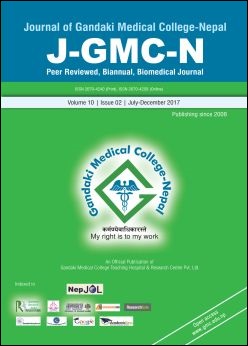Cutaneous Adverse Drug reactions: A Four-Year Study from Western Nepal
DOI:
https://doi.org/10.3126/jgmcn.v10i2.20804Keywords:
Antibacterial agents, Cefixime, Exanthema, Stevens-Johnson syndromeAbstract
Background: Cutaneous adverse drug reactions (CADRs) range from minor reactions to several life threatening complications. Objectives: To study the clinical spectrum of cutaneous adverse drug reactions, determine the causative drugs responsible for the reactions and to assess the preventability.
Methods: The study was carried out in the Department of Dermatology of Gandaki Medical College Teaching Hospital from June 2011 to June 2015. All the patients attending the Dermatology Outpatient Department and the patients admitted in the wards with suspected cutaneous adverse drug reactions to systemic drugs were included in the study. A detailed clinical history, including the history of drug intake was noted. Each case was assessed for its causality by using the WHO definitions. Data analysis was done using SPSS software.
Results: There were 102 patients in total. The mean age of the patient was 32 ±15.7 years. Maximum patients belonged to the 21 to 30 years age group. There were 59 female patients and 43 male patients. Severe type of cutaneous adverse drug reactions was noted in 7.8% of patients. Antibiotics were responsible for most of the cutaneous adverse drug reactions. Cefixime was the most commonly incriminated drug. Exanthematous drug reaction was the most common type seen in 45%. Stevens-Johnson syndrome was the commonest type noted among the serious adverse drug reactions. Drug preventability was noted in 6% of patients.
Conclusions: The commonest type of CADR noted was exanthematous type. Antibiotics were the commonest drug group involved in CADR. Six percent of CADR were preventable.
J-GMC-N | Volume 11 | Issue 01 | January-June 2018, Page: 21-26
Downloads
Downloads
Published
How to Cite
Issue
Section
License
This license allows reusers to distribute, remix, adapt, and build upon the material in any medium or format for noncommercial purposes only, and only so long as attribution is given to the creator.




